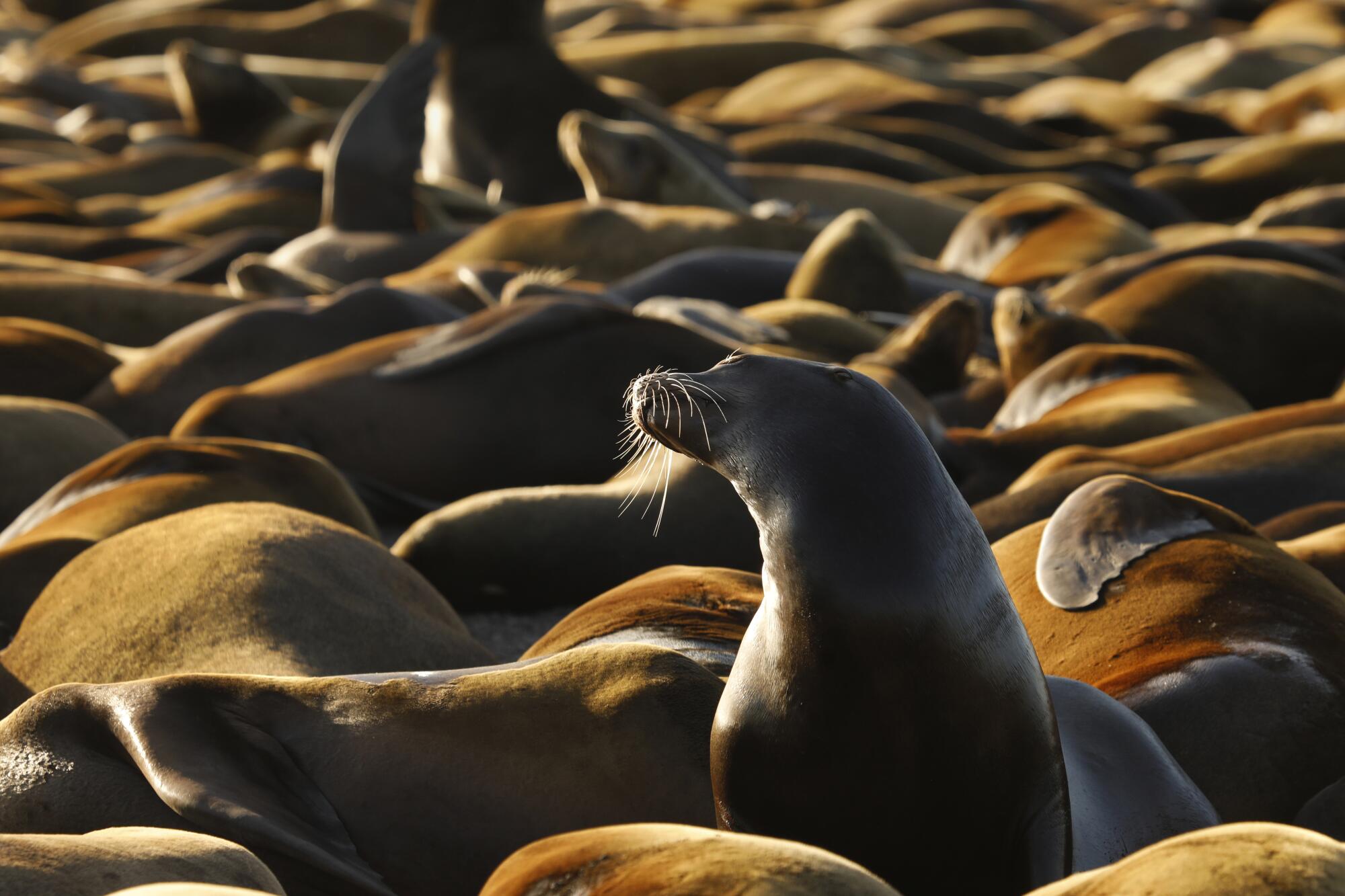
- Share via
On May 7, Patrick Robinson took a boat out to Año Nuevo Island to survey the sea lions that come to birth on this rocky outcropping north of Monterey Bay.
The shore was littered with dead pups — babies that looked as though they’d been delivered too early and therefore were too weak and small to nurse, or had been dead at birth.
Similar observations were being made further down the coast on San Miguel Island in the Channel Islands — where massive colonies of sea lions gather every year — and as far south as Mexico.
Aggressive and impactful reporting on climate change, the environment, health and science.
Robinson, the director of UC Santa Cruz’s Año Nuevo Reserve, said it’s not unusual to see some dead pups this time of year. He said sick or malnourished females occasionally stop on their way south to abort. But the numbers he was seeing were alarming. And with the peak of birthing season still several weeks away, it augurs a potentially serious and worrisome situation.
Stranding coordinators and biologists up and down the California coast say there is clearly something going on, but they still don’t know what.
Tests for bird flu — which has obliterated populations of sea lions and elephant seals in South America — are being processed. So, too, are tests for domoic acid, which has poisoned large numbers of sea lions in the past, as well as other common pathogens.
“In a typical year, one might expect to see 5 to 10,” dead pups, said Megan Moriarty, a veterinarian at UC Santa Cruz. “But we have now counted 250 to 300 dead sea lion pups” on Año Nuevo Island.
She said observations included dead or stillborn pups, aborted fetuses, malnourished pups, and adult females with dystocia — difficult births — who are also thin.
“Unfortunately, widespread premature dead pups have also been reported in the Channel Islands (San Miguel), which is a crucial nursery area for California sea lions,” she said. “The cause and impact of these mortalities remains unknown.”
Our oceans. Our public lands. Our future.
Get Boiling Point, our new newsletter exploring climate change and the environment, and become part of the conversation — and the solution.
You may occasionally receive promotional content from the Los Angeles Times.
She and Sharon Melin, a research biologist with the National Oceanic and Atmospheric Administration’s Alaska Fisheries Science Center, said there are many potential reasons for widespread sea lion pup mortalities, including environmental factors, such as malnourishment, lack of available food related to El Niño, infectious causes (bacteria, viruses such as leptospirosis, influenza, brucella, coxiella, and others), and toxins (such as domoic acid).
And although they both think testing for bird flu is warranted — considering it is a multi-species global outbreak — “we have not observed neurologic or respiratory signs in the sea lions at Año Nuevo,” Moriarty said.
“Reproductive failures and stillborn animals have not been a common finding with influenza A infections in marine mammals globally,” she said.
Melin said about 25,000 pups are born in the Channel Islands every year.
“In some years — particularly in El Niño years, or sometimes heatwave years or other oddities that go on in the environment — we’ll have something like 20% to 30% premature pups,” she said.
Scientists have found DDT in zooplankton and deep-sea fish off the coast of L.A., indicating the toxic chemical might be infiltrating the base of the food web.
She said the pups born this time of year are often not “fully baked.”
“They could just stay in a little bit longer ... and probably if you could put them in an incubator and take care of them, they might survive,” she said.
And when necropsies are done on these tiny pups, “you’ll see that the very last thing to develop fully are their lungs. ... So they’re just not quite fully developed enough to breathe on their own and to be successful. They’ll sometimes live for a couple days at this point, but can’t nurse and don’t have the motor skills to hold their head up or nurse effectively.”
She said the mothers will usually try hard to get the pups to nurse, “they don’t know what’s going on, and they’re trying to figure out why they’re not nursing. So there’s kind of a lot of interaction that goes on there, but usually the pup will just end up dying after a short period of time.”
Michael Milstein, a spokesperson for the National Oceanic and Atmospheric Administration, said the most recent fisheries survey found “considerable declines in anchovy off the south half of the state, where most of the strandings are.”
He said observations of predators and seabirds were more scattered, “suggesting they are tracking more dispersed prey.” He said surveys farther north have not yet been completed.
Some 1,100 to 1,200 sea lions have been counted flopping on and around the docks at San Francisco’s Pier 39 in recent days — the highest number recorded in 15 years.
But high numbers of brown pelican deaths, and major declines in California’s chinook salmon populations, have many concerned about broader ecosystem troubles.
This year, fishery managers decided to ban salmon fishing along the coast and in rivers for a second straight year, seeking to help chinook stocks recover.
Stranding coordinators and biologists say the good news is that the California sea lion population is healthy and robust; however, rescue centers are filling up with sick and malnourished pups.
Researchers found high levels of microplastics in human and dog testes. They say their presence could be behind a trend in diminishing sperm quantity and quality around the globe.
More to Read
About this article











